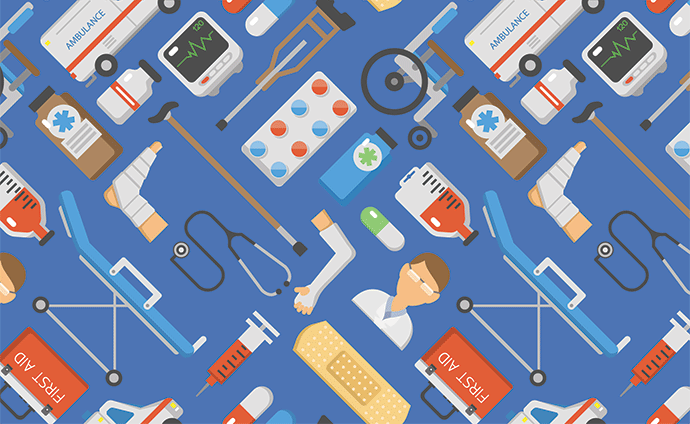
Digital Transformation: Making Electronic Health Records Work for Patients and Healthcare Providers
November 26, 2023Table of Contents
Introduction: Driving Digital Transformation through Patient-Centered Electronic Health Records (EHR)
A. Brief Background on Electronic Health Record (EHR) Adoption
- Overview of EHR Implementation: In the evolving landscape of healthcare, the adoption of Electronic Health Records (EHRs) stands as a pivotal milestone. EHRs represent a digital transformation of patient health information, replacing traditional paper records with comprehensive, electronic systems. This shift promises streamlined data management, improved healthcare delivery, and enhanced patient outcomes.
- Key Challenges: Usability, Interoperability, Costs: However, the journey toward widespread EHR adoption is not without challenges. Usability concerns, interoperability issues, and the financial burdens associated with implementation have marked the path. The complexities of integrating EHRs into diverse healthcare ecosystems have prompted a critical examination of how these digital systems align with the fundamental goal of providing patient-centric care.
B. Driving Digital Transformation through Patient-Centered EHR
Amidst the challenges and opportunities, this exploration delves into the role of Electronic Health Records (EHRs) as drivers of digital transformation, with a specific emphasis on placing patients at the center of this evolution. The thesis asserts that optimizing EHRs for patient-centered care is not only essential for overcoming current challenges but also a transformative step toward achieving a healthcare landscape where technology enhances the patient experience, fosters engagement, and ultimately contributes to improved health outcomes. This journey navigates the intersection of technology and patient-centric care, seeking to unravel the potential of EHRs as catalysts for a more connected, efficient, and personalized healthcare ecosystem.
Improving EHR Ease of Use: Navigating Challenges and Strategies for Enhanced Usability
A. Identifying Challenges in Current EHR Interfaces
- Staff Frustration and Reduced Productivity: One of the critical challenges in current Electronic Health Record (EHR) interfaces lies in the frustration experienced by healthcare staff, leading to reduced productivity. Cumbersome interfaces, complex workflows, and inefficient data entry processes contribute to a sense of disengagement among users. The disconnect between the intended benefits of EHRs and the day-to-day experiences of healthcare professionals becomes evident, impacting both job satisfaction and patient care.
B. Strategies for Enhanced Usability
- Intuitive Workflows and User-Friendly Design:
- Streamlining Navigation: Reducing cognitive load on users by optimizing navigation pathways within the EHR interface. Intuitive menus, clear information hierarchies, and context-aware navigation can enhance user experience.
- Customizable Dashboards: Allowing healthcare professionals to personalize their dashboards based on individual preferences and roles. This flexibility ensures that users can access the most relevant information quickly, fostering a more efficient workflow.
- Simplified Documentation Processes:
- Natural Language Processing (NLP) Integration: Implementing NLP technology to facilitate natural and efficient documentation. NLP can assist in converting spoken words into structured text, simplifying the documentation process and reducing the time spent on manual data entry.
- Templates and Macros: Providing pre-built templates and macros for common documentation scenarios. This empowers healthcare professionals to create detailed and accurate records with minimal effort, optimizing the documentation process.
- Optimization of Data Entry Workflows:
- Voice Recognition Technology: Integrating voice recognition tools to enable hands-free data entry. This not only enhances efficiency but also reduces the physical strain on healthcare professionals, allowing them to focus more on patient care.
- Smart Forms and Autocomplete: Implementing smart forms with autocomplete features to speed up data entry. By predicting and auto-filling information based on context, these features reduce manual input, minimizing errors and enhancing overall usability.
In the pursuit of improving EHR ease of use, addressing the identified challenges requires a strategic approach centered around intuitive design and user-friendly functionalities. By incorporating these strategies, the aim is to transform EHRs from sources of frustration to tools that empower healthcare professionals, ultimately contributing to an environment where technology facilitates rather than hinders the delivery of patient-centered care.
Enhancing Interoperability: Overcoming Data Exchange Challenges for Collaborative Healthcare
A. Addressing Data Exchange Challenges
- Integration Across Health Systems: The challenge of interoperability often stems from the siloed nature of health systems, where data exchange encounters barriers due to incompatible formats and disparate technologies. This fragmentation impedes the seamless flow of information critical for providing comprehensive patient care.
B. Health Data Standards
- HL7 and FHIR Implementation:
- HL7 Standards: Health Level Seven (HL7) standards serve as a foundational framework for the exchange, integration, sharing, and retrieval of electronic health information. Implementation of HL7 standards ensures a common language for healthcare systems to communicate effectively.
- Fast Healthcare Interoperability Resources (FHIR): FHIR represents a modern approach to data exchange, offering a more flexible and developer-friendly standard. By using RESTful APIs, FHIR facilitates real-time data access, promoting interoperability between disparate systems.
- Role of HIE and IDNs in Promoting Collaboration:
- Health Information Exchanges (HIE): HIEs play a pivotal role in fostering collaboration by acting as intermediaries that enable the secure sharing of patient information among different healthcare entities. These platforms facilitate the seamless exchange of data, supporting coordinated care and reducing duplicative efforts.
- Integrated Delivery Networks (IDNs): IDNs bring together various healthcare providers and facilities under a unified infrastructure. By implementing standardized interoperability protocols, such as HL7 and FHIR, IDNs promote a cohesive ecosystem where health information flows seamlessly across affiliated entities.
Achieving enhanced interoperability necessitates a concerted effort to address data exchange challenges and establish standardized frameworks. The implementation of robust standards like HL7 and FHIR, coupled with the strategic roles played by HIEs and IDNs, paves the way for a collaborative healthcare landscape where information flows seamlessly, ensuring that patients receive holistic and well-coordinated care across diverse healthcare systems.
Analytics Drive Decisions: Empowering Informed Decision-Making through Data Insights
- Clinical Decision Support Systems:
- Data-Driven Clinical Guidance: Clinical Decision Support Systems (CDSS) harness the power of analytics to provide healthcare professionals with real-time, evidence-based information at the point of care. These systems analyze patient data, medical literature, and best practices to offer personalized recommendations, enhancing the decision-making process.
- Alerts and Reminders: CDSS can generate alerts and reminders based on predefined algorithms, ensuring healthcare providers are informed about critical aspects of patient care. These prompts contribute to improved adherence to guidelines, reducing errors and enhancing overall patient safety.
- Data Visualizations for Insights:
- Interactive Dashboards: Leveraging data visualizations through interactive dashboards provides a dynamic and comprehensible representation of complex healthcare data. These visuals enable healthcare professionals to identify patterns, trends, and outliers, fostering a deeper understanding of patient populations and facilitating strategic decision-making.
- Real-Time Monitoring: Data visualizations offer real-time insights into key performance indicators, allowing healthcare organizations to monitor patient outcomes, resource utilization, and operational efficiency. Timely access to such information empowers decision-makers to respond promptly to emerging trends or issues.
- Predictive Algorithms and Real-Time Alerts:
- Proactive Risk Assessment: Predictive analytics utilize advanced algorithms to assess patient risk factors and predict potential health outcomes. By identifying patients at risk of deterioration or complications, healthcare providers can implement preventive measures and interventions, optimizing patient care.
- Real-Time Alerts: Real-time alerts generated by predictive algorithms notify healthcare teams about critical events or changes in patient conditions. These alerts serve as early warning systems, enabling rapid responses and interventions to mitigate risks and improve patient outcomes.
In conclusion, analytics-driven decision-making forms the cornerstone of modern healthcare, offering a transformative approach to patient care. From leveraging Clinical Decision Support Systems for evidence-based guidance to utilizing data visualizations and predictive algorithms, healthcare professionals are empowered to make informed decisions that enhance patient safety, optimize resource allocation, and improve overall healthcare delivery. The integration of analytics not only streamlines decision-making processes but also contributes to a data-driven culture that prioritizes precision, efficiency, and improved patient outcomes.
Security and Compliance: Safeguarding Patient Data Privacy in the Digital Era
- Ensuring Patient Data Privacy:
- Importance of HIPAA Compliance: The Health Insurance Portability and Accountability Act (HIPAA) stands as a cornerstone in safeguarding patient data privacy. Compliance with HIPAA regulations ensures that healthcare organizations implement stringent measures to protect the confidentiality and security of patient information. This includes electronic protected health information (ePHI) stored and transmitted within the healthcare ecosystem.
- Audits and Monitoring for Compliance: Regular audits and continuous monitoring play a crucial role in maintaining and demonstrating HIPAA compliance. Audits assess the effectiveness of security measures, identify vulnerabilities, and ensure that healthcare organizations adhere to the stipulated privacy and security standards. Ongoing monitoring provides real-time insights into potential security breaches, allowing for prompt remediation and proactive risk management.
- Innovations in Security, including Blockchain: Emerging technologies, such as blockchain, are being explored for their potential to enhance security in healthcare. Blockchain’s decentralized and tamper-resistant nature can contribute to secure storage and sharing of patient data. By providing a transparent and immutable ledger, blockchain technology has the potential to fortify data integrity and reduce the risk of unauthorized access.
In the dynamic landscape of healthcare technology, security and compliance are paramount considerations. Ensuring patient data privacy involves not only adherence to regulatory frameworks like HIPAA but also leveraging innovative solutions to address evolving security challenges. As healthcare organizations navigate the digital era, a comprehensive approach that combines regulatory compliance, robust auditing practices, and cutting-edge security technologies becomes essential to build a resilient and secure healthcare ecosystem.
Conclusion: Localizing EHR Digital Transformation for Patient-Centric Excellence
A. Key Localization in EHR Digital Transformation Efforts
- Patient-Provider Collaboration Paradigm: The essence of successful Electronic Health Record (EHR) digital transformation lies in the localization of efforts toward fostering a patient-provider collaboration paradigm. The ultimate goal is to create an ecosystem where EHRs cease to be mere repositories of clinical data and instead become dynamic tools that facilitate meaningful interactions between patients and healthcare providers.
- Patient Empowerment: Localization involves placing patients at the center of their healthcare journey, empowering them with access to their health information, personalized insights, and tools for active engagement. This paradigm shift transforms patients from passive recipients of care to active participants in their health management.
- Provider Enablement: Simultaneously, localization ensures that healthcare providers are equipped with EHR systems that enhance rather than hinder their ability to deliver high-quality, patient-centric care. Usability improvements, streamlined workflows, and interoperability contribute to a more efficient and satisfying experience for healthcare professionals.
2. Recap of Focus Keyphrases: As we conclude this exploration of EHR digital transformation, it is essential to revisit the focus keyphrases that have underscored our journey:
- Patient-Centered Care: The pivotal shift towards placing patients at the heart of healthcare, with EHRs serving as enablers of personalized, collaborative, and holistic care.
- Enhanced Usability: Efforts to address challenges in EHR interfaces, making them more intuitive, user-friendly, and aligned with the needs and workflows of healthcare professionals.
- Interoperability Solutions: Strategies to overcome data exchange challenges and implement health data standards, ensuring seamless collaboration across diverse health systems.
- Analytics-Driven Decisions: The utilization of data analytics, clinical decision support systems, and predictive algorithms to empower healthcare professionals with actionable insights for informed decision-making.
- Security and Compliance: The imperative to ensure patient data privacy through adherence to regulatory frameworks like HIPAA, audits, monitoring, and the exploration of innovative security solutions, including blockchain.
In the intricate tapestry of EHR digital transformation, these keyphrases serve as guiding principles, steering the healthcare industry towards a future where technology and patient-centric care converge harmoniously.
In the localized pursuit of excellence, EHRs become catalysts for transformative healthcare experiences, where the collaboration between patients and providers is seamless, informed decisions drive positive outcomes, and the safeguarding of patient data remains non-negotiable. The journey continues, propelled by the commitment to localize EHR digital transformation efforts for the betterment of healthcare worldwide.


